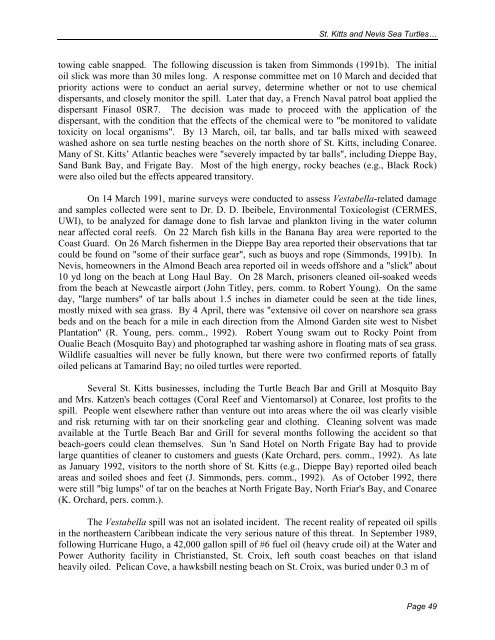Sea Turtle Recovery Action Plan for St. Kitts and Nevis - WIDECAST
Sea Turtle Recovery Action Plan for St. Kitts and Nevis - WIDECAST
Sea Turtle Recovery Action Plan for St. Kitts and Nevis - WIDECAST
Create successful ePaper yourself
Turn your PDF publications into a flip-book with our unique Google optimized e-Paper software.
<strong>St</strong>. <strong>Kitts</strong> <strong>and</strong> <strong>Nevis</strong> <strong>Sea</strong> <strong>Turtle</strong>s…<br />
towing cable snapped. The following discussion is taken from Simmonds (1991b). The initial<br />
oil slick was more than 30 miles long. A response committee met on 10 March <strong>and</strong> decided that<br />
priority actions were to conduct an aerial survey, determine whether or not to use chemical<br />
dispersants, <strong>and</strong> closely monitor the spill. Later that day, a French Naval patrol boat applied the<br />
dispersant Finasol 0SR7. The decision was made to proceed with the application of the<br />
dispersant, with the condition that the effects of the chemical were to "be monitored to validate<br />
toxicity on local organisms". By 13 March, oil, tar balls, <strong>and</strong> tar balls mixed with seaweed<br />
washed ashore on sea turtle nesting beaches on the north shore of <strong>St</strong>. <strong>Kitts</strong>, including Conaree.<br />
Many of <strong>St</strong>. <strong>Kitts</strong>’ Atlantic beaches were "severely impacted by tar balls", including Dieppe Bay,<br />
S<strong>and</strong> Bank Bay, <strong>and</strong> Frigate Bay. Most of the high energy, rocky beaches (e.g., Black Rock)<br />
were also oiled but the effects appeared transitory.<br />
On 14 March 1991, marine surveys were conducted to assess Vestabella-related damage<br />
<strong>and</strong> samples collected were sent to Dr. D. D. Ibeibele, Environmental Toxicologist (CERMES,<br />
UWI), to be analyzed <strong>for</strong> damage done to fish larvae <strong>and</strong> plankton living in the water column<br />
near affected coral reefs. On 22 March fish kills in the Banana Bay area were reported to the<br />
Coast Guard. On 26 March fishermen in the Dieppe Bay area reported their observations that tar<br />
could be found on "some of their surface gear", such as buoys <strong>and</strong> rope (Simmonds, 1991b). In<br />
<strong>Nevis</strong>, homeowners in the Almond Beach area reported oil in weeds offshore <strong>and</strong> a "slick" about<br />
10 yd long on the beach at Long Haul Bay. On 28 March, prisoners cleaned oil-soaked weeds<br />
from the beach at Newcastle airport (John Titley, pers. comm. to Robert Young). On the same<br />
day, "large numbers" of tar balls about 1.5 inches in diameter could be seen at the tide lines,<br />
mostly mixed with sea grass. By 4 April, there was "extensive oil cover on nearshore sea grass<br />
beds <strong>and</strong> on the beach <strong>for</strong> a mile in each direction from the Almond Garden site west to Nisbet<br />
<strong>Plan</strong>tation" (R. Young, pers. comm., 1992). Robert Young swam out to Rocky Point from<br />
Oualie Beach (Mosquito Bay) <strong>and</strong> photographed tar washing ashore in floating mats of sea grass.<br />
Wildlife casualties will never be fully known, but there were two confirmed reports of fatally<br />
oiled pelicans at Tamarind Bay; no oiled turtles were reported.<br />
Several <strong>St</strong>. <strong>Kitts</strong> businesses, including the <strong>Turtle</strong> Beach Bar <strong>and</strong> Grill at Mosquito Bay<br />
<strong>and</strong> Mrs. Katzen's beach cottages (Coral Reef <strong>and</strong> Vientomarsol) at Conaree, lost profits to the<br />
spill. People went elsewhere rather than venture out into areas where the oil was clearly visible<br />
<strong>and</strong> risk returning with tar on their snorkeling gear <strong>and</strong> clothing. Cleaning solvent was made<br />
available at the <strong>Turtle</strong> Beach Bar <strong>and</strong> Grill <strong>for</strong> several months following the accident so that<br />
beach-goers could clean themselves. Sun 'n S<strong>and</strong> Hotel on North Frigate Bay had to provide<br />
large quantities of cleaner to customers <strong>and</strong> guests (Kate Orchard, pers. comm., 1992). As late<br />
as January 1992, visitors to the north shore of <strong>St</strong>. <strong>Kitts</strong> (e.g., Dieppe Bay) reported oiled beach<br />
areas <strong>and</strong> soiled shoes <strong>and</strong> feet (J. Simmonds, pers. comm., 1992). As of October 1992, there<br />
were still "big lumps" of tar on the beaches at North Frigate Bay, North Friar's Bay, <strong>and</strong> Conaree<br />
(K. Orchard, pers. comm.).<br />
The Vestabella spill was not an isolated incident. The recent reality of repeated oil spills<br />
in the northeastern Caribbean indicate the very serious nature of this threat. In September 1989,<br />
following Hurricane Hugo, a 42,000 gallon spill of #6 fuel oil (heavy crude oil) at the Water <strong>and</strong><br />
Power Authority facility in Christiansted, <strong>St</strong>. Croix, left south coast beaches on that isl<strong>and</strong><br />
heavily oiled. Pelican Cove, a hawksbill nesting beach on <strong>St</strong>. Croix, was buried under 0.3 m of<br />
Page 49
















